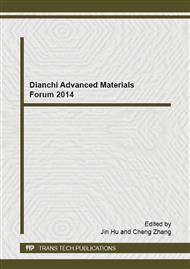p.229
p.236
p.240
p.244
p.248
p.253
p.257
p.261
p.265
Study of Natural Dye Sensitized Solar Cells with TiO2/ZnO Composite Thin Film as Photoanode
Abstract:
TiO2/ZnO composite thin film was prepared by sequentially spread TiO2 and ZnO thin film on the ground layer by layer with sol-gel method respectively. Two different natural dyes (Hehuang safflower yellow pigment and Lycium ruthenicum Murr pigment) were used as sensitizer respectively to sensitize TiO2/ZnO thin film photoanodes and be assembled into solar cells. Dipping time of photoanodes stayed in sensitizer was investigated systematically and the results show that higher photovoltaic conversion efficiency can be obtained with extension of immersing time. The phase structure, crystallinity, morphology and optical property of photoanode were characterized based on XRD, SEM and UV-vis measurements.
Info:
Periodical:
Pages:
248-252
Citation:
Online since:
November 2014
Authors:
Keywords:
Price:
Сopyright:
© 2014 Trans Tech Publications Ltd. All Rights Reserved
Share:
Citation:


